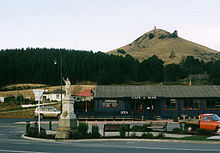Palmerston, New Zealand
Located 50 kilometres to the north of the city of Dunedin, it is the largest town in the Waihemo Ward of the Waitaki District, with a population of 890 residents.
The Main South Line railway passes through the town and the Seasider tourist train travels from Dunedin to Palmerston and back once or twice a week.
Modern archaeology favours a date for the first settlement of New Zealand by Polynesian people about 1150 AD when population was concentrated on the east coast of the South Island.
There is a substantial early settlement site of the Archaic or moa hunter phase of Māori culture near Palmerston on the sea coast at the mouth of the Shag River.
There are several versions of the tradition but they tell of the arrival of Rākaihautū from the ancestral homeland Hawaiki who met the Kahui Tipua people who were already here.
He showed them kumara, or sweet potatoes, and they built canoes including Arai Te Uru to go to Hawaiki and bring back this new and valuable food.
It spilled food baskets on Moeraki and Katiki beaches and was wrecked at Shag Point / Matakaea, where it turned into what is now called Danger Reef.
When she got back to the Waihemo Valley dawn broke and she was turned into the hill Puketapu overlooking Palmerston.
It is tempting to identify the occupants of the river mouth archaeological site with the people of Arai Te Uru but that can only be speculation.
In 1814 an open boat from the Matilda, Captain Fowler, under the first mate Robert Brown, with two other Europeans and five lascars, or Indian seamen, came up the east coast past Palmerston and camped for the night ashore north of Moeraki.
According to the Creed manuscript, discovered in 2003, two men 'escaped through the darkness of the night & fled as far as Goodwood Bobby's Head' a little south of Palmerston on the coast.
In May 1826 Thomas Shepherd, (1779–1835), passing this coast in the Rosanna, made a sketch of it which still survives in the Mitchell Library, Sydney.
Charles Suisted took up land in the area in the 1850s and Palmerston came into existence as a camp site in 1862 as the beginning of a route by the Shag Valley to the Central Otago gold diggings.
A marble statue of Zealandia by Carlo Bergamini in the centre of the town is a Boer War memorial.
[4] St Mary's Anglican church is situated on Stromness street and was built in 1872 and designed by architect RA Lawson.


